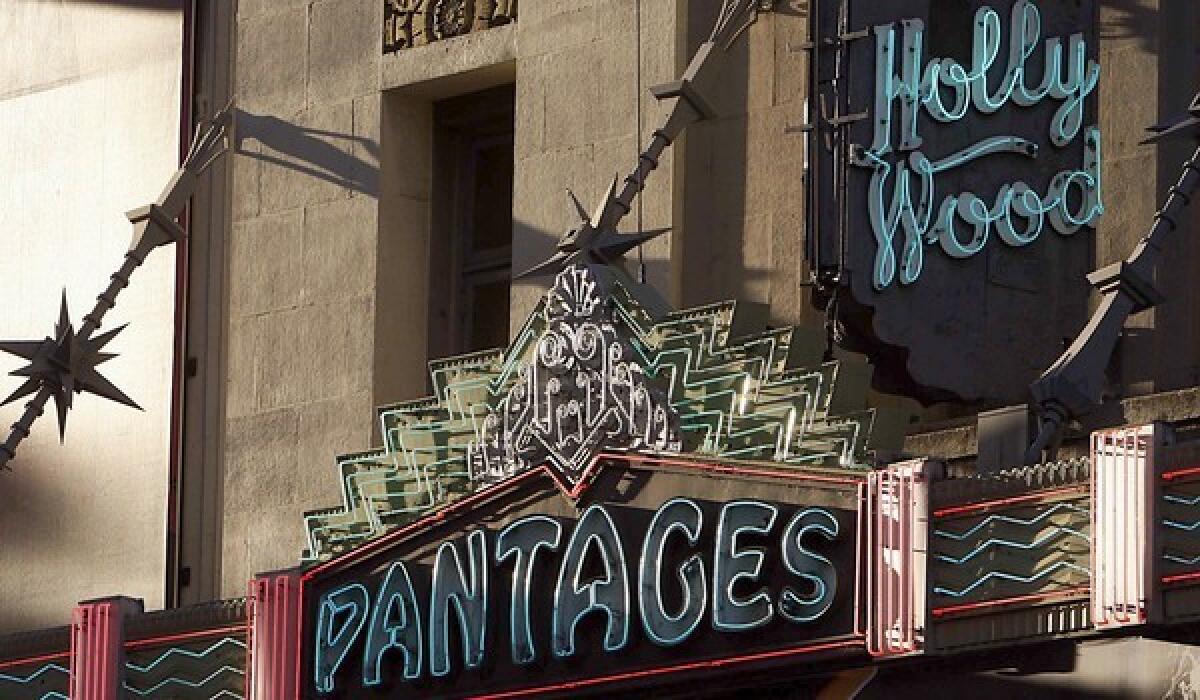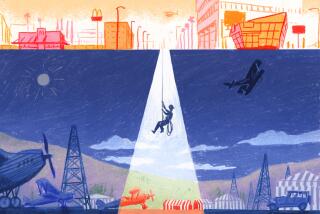Brick-and-mortar treasures in Tinseltown

Like an old movie set, original Hollywood was dismantled ages ago, leaving what appears to be scant trace of its hallowed roots: The Hollywood Hotel (where Louis B. Mayer and a long list of silent movie stars stayed). The Hollywood Brown Derby (where Clark Gable reportedly proposed to Carole Lombard in booth No. 5). The Hollywood Canteen (where celebrity volunteers waited on tables and the millionth WWII serviceman guest got a kiss from Betty Grable).
Unless, that is, you show up for a $10, 31/2-hour Saturday morning walking tour with Hollywood Heritage Inc., a 30-year-old preservationist group dedicated to saving Hollywood’s vintage landmarks and helping vaguely nostalgic visitors notice that all, in fact, is not lost here.
“Here we stand at the very spot where the whole Hollywood ‘gold rush’ arguably started,” says Hans Obma, a volunteer guide with Hollywood Heritage, holding court on a street corner near Hollywood and Vine with today’s Saturday morning tour crowd — a trio of middle-aged women from the Valley and a journalist masked in sun block.
“In 1913,” recounts Obma, “three young men named Cecile B. DeMille, Jesse Lasky and Samuel Goldfish [Goldwyn] pooled all their resources together, rented out an old horse barn right on this corner and made a movie called “The Squaw Man.” It was the first feature-length film shot right here in Hollywood. And it was a gamble that obviously paid off.”
Not that any of this is obvious from where we’re standing. Today, the original home of Paramount Pictures is a parking lot.
“We’ve lost our share of treasures over the years, as you can see,” says Obma, clutching a leather-bound case filled with old black-and-white images of Hollywood’s demolished past. “But I think you’ll be pleasantly surprised this morning by what’s still out there.”
Just up the road at the famous corner of Hollywood and Vine, some historic edifices mark the spot — including the 1920s-era Taft and Broadway Hollywood buildings and a partially spared Spanish Colonial facade of the old Brown Derby.
Around the corner is the Pantages Theatre, an Art Deco classic built in 1929 that hosted Academy Award shows during the 1950s. Right next door is the still-breathing Frolic Room, a bar harking back to the same era. A block north is the Capitol Records building — “the world’s first circular office building,” Obma tells us, “which, contrary to popular belief, was not inspired by a stack of vinyl records.”
The tour meanders west along Hollywood Boulevard and some of its tributaries, hitting other blasts from the past such as the old Knickerbocker Hotel, the gorgeously restored Egyptian Theatre and its resuscitated neighbor, the Pig N’ Whistle (home of 1930s-era premiere parties), among several other not-unexpected stops.
But it’s the smaller, less conspicuous stuff along the way that really brings Hollywood into a new — meaning old — light.
There’s a closet-sized smoke shop in the 6400 block next to the dormant 1920s-era Warner Bros. Theatre (now the Hollywood Pacific Theatre) that’s somehow been unscathed for 80-odd years. And a Prohibition-era stone stairwell to a speak-easy entrance hiding behind a chain-link fence.
Tucked away in the rear of a commercial courtyard behind a Thai massage parlor and a Mexican restaurant is the 1903 Janes House — Hollywood Boulevard’s last Queen Anne home, which also served as a neighborhood school attended by the offspring of Douglas Fairbanks, DeMille and Charlie Chaplin. In the lobby of the old Guaranty Building, a 1923 Beaux Arts office structure, an old Hollywood timeline-style mural hides on a side wall near the elevators.
In today’s Hollywood mishmash, relics like these are easy to miss. If you want to find them, it helps to be walking slowly (sorry, double-decker bus tour passengers) and chaperoned by an organization committed to saving what’s left.
Along the boulevard, we spot an ornate, Churrigueresque-style terra cotta facade above a souvenir shop. And then some impressive Gothic arches one story above a fast-food joint. You wouldn’t notice any of this historical punctuation without glancing above ground level. Until now, despite logging several visits to Hollywood, I barely have.
“I always say on my tours that the history of Hollywood Boulevard is mostly above the first floor,” says George Kiel, a Hollywood Heritage docent, board of directors member and the prime mover behind these weekly tours. “The vast majority of our clientele are locals as opposed to the movie-star tour crowd,” he adds. “People who’ve driven up and down Hollywood Boulevard all their lives gain such a different perspective walking down the street and taking the time to really see it.”
Above the tchotchke shops, between the pizza counters, behind the construction fences, inside some nondescript doorway, tenacious bits and pieces of bygone Hollywood turn up again and again. They’re older than George Clooney. Heartier than Gov. Arnold Schwarzenegger. Cooler than Big Bird’s star on the Walk of Fame. Sometimes they even have a name and shake your hand.
“Welcome to Musso & Frank Grill,” says Manuel Felix, a red-jacketed fixture at the oldest restaurant in Hollywood (established in 1919), greeting us at the door.
Felix, who’s been working here since 1974, can’t quite recall the days when Mary Pickford, Greta Garbo and Nathanael West frequented this time capsule of a dining room filled with mahogany, red leather and inebriated ghosts, but he graciously answers several questions about all of that. “Yeah,” he says. “Hollywood was built around this place.”
“Welcome to Miceli’s,” says Mike Andolini a few blocks later, a 23-year veteran at Hollywood’s most seasoned Italian joint, which hides on a side street just south of the boulevard. “You wanna know how old this place is? It’s old,” he says, pointing to a framed menu dating to 1949, back when “Twelve O’Clock High” was in the theaters and large pizzas here set you back $1.20. “Thanks for coming by,” says Andolini, a SAG member, handing over a business card with his film credits. “Keep in touch.”
The tour ends in the lobby at the famous Roosevelt Hotel, which opened in 1927 and features a Gable-Lombard penthouse that comes by the name honestly. Recently, the building received a major renovation that led to some head-butting between the hotel and folks at Hollywood Heritage, led by the organization’s late director of preservation issues, Robert Nudelman.
“He chalked up some major victories in this place,” says Obma, pointing out some original floor tiles (“saved, thank God”) before stealthily herding us toward a private side room off of the lobby.
“The Blossom Room,” he whispers. “It’s where the very first Academy Awards ceremony happened in 1929. We can try and sneak a peek if you want.”
Of course we do. This is Hollywood. Whatever it is and whatever it’s becoming, some of that original set design hasn’t entirely left the building.
*
TAKE THE TOUR
Hollywood Heritage Inc. offers public walking tours of downtown Hollywood at 9 a.m. Saturdays. Tours are 31/2 hours long, cover several blocks of Hollywood Boulevard and cost $10 for nonmembers ($5 for members). Tours must be booked with an advance reservation; (323) 465-6716, https://www.hollywoodheritage.org
More to Read
Sign up for The Wild
We’ll help you find the best places to hike, bike and run, as well as the perfect silent spots for meditation and yoga.
You may occasionally receive promotional content from the Los Angeles Times.






